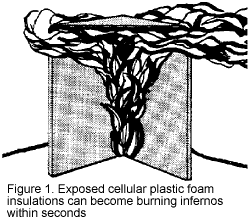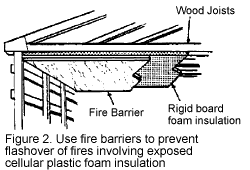Both rigid board foam and sprayed-on cellular plastic foam insulations present serious fire problems when installed as an exposed finish in farm buildings. Insulation foams are most often developed from plastic polystyrenes, polyurethanes, and polyisocyanurates.
| Table 1. Flame Spread Ratings for Various Materials | |
| Interior Finish Material | Flame Spread Rating |
| Asbestos-cement
board 1/2 in. or 5/8 in. gypsum wall |
0 |
| board
(dry wall) 1/2 in. treated (fire retardant) |
15 |
| exterior plywood | 20-25 |
| Red oak lumber | 100 |
| Untreated
exterior plywood (various thicknesses) |
75-200 |
The manufacturers of these insulations imply that the materials themselves aren't hazardous, but that improper use or application can create hazards. But many fire experts say that the materials are hazardous because of the typical way that they are applied. The reason for the difference in opinions is the way the insulations have been tested. The manufacturers tested the flammability of the product in the horizontal mode. The flame spread in this position is minimal. However, others have tested the foam insulations in the vertical position. When tested this way, the results are far different.
Just
who is technically correct is of little consequence. The fact
that foam insulation has been involved in millions of dollars
of losses to potato and apple storages, swine houses, poultry
plants and other livestock housing is undebated. A common
fact is that fires in buildings with foam insulation have
spread with alarming speed, resulting in clouds of black dense
smoke and devastating loss. It is also a fact that there are
many different foam materials with widely different flammability
but under certain conditions all of these materials will burn.
Even self-extinguishing foams burn (or else they could not
self extinguish under certain situations).
FLAME
SPREAD
 A yardstick for determining the suitability of certain materials
for specific interior finishes in buildings is called flame
spread. Examples of Flame spread ratings given to various materials
are listed in Table 1.
A yardstick for determining the suitability of certain materials
for specific interior finishes in buildings is called flame
spread. Examples of Flame spread ratings given to various materials
are listed in Table 1.
FLAME SPREAD
A yardstick for determining the suitability of certain materials for specific interior finishes in buildings is called flame spread. Examples of Flame spread ratings given to various materials are listed in Table 1.
Flame spread tests of rigid plastic insulation boards show flame spread ratings ranging from 25-2500, depending on the position of the board (horizontal or vertical, surface or corner) and the ignition source. However, in most cases the insulation flashed over (became fully involved by fire) in slightly over one minute. This indicates two things; one, that the insulation does allow rapid flame spread (see Figure 1) and secondly, that exposed foamed insulation can burn at such a rapid rate that evacuation of a building lined with this type of insulation is nearly impossible.
Building codes typically require that foam insulation be protected with fire resistant barriers because of the foam's relatively low decomposition temperature, questionable flame spread, potential toxic gas generation and high smoke emission. But exposed cellular plastic insulation has been allowed in farm buildings because building codes often are not enforced or are not applicable in rural areas. You should act now to minimize the fire risks to buildings that contain exposed cellular plastic insulation. Many insurance companies that sell farm policies are requiring policy holders to upgrade buildings with exposed foam insulation by either covering the foam insulation or removing it completely.
Upgrading the fire resistance of foam insulation is expensive after the building has been in use several years. In these buildings it's too late to consider using alternative insulation systems. Typical 1982 estimates for adding fire barriers to existing buildings range between $.75 to $1.50 per square foot.
FIRE BARRIERS
Some cellular plastic foams melt at temperatures as low as 270 degrees. This may be as little as 180-200 degrees over room temperature.
Publication #: 20
This document was published in 1988 as Pennsylvania State University Fact Sheet Safety, Pennsylvania Cooperative Extension Service. For more information, contact Pennsylvania State University College of Agricultural Sciences, Agricultural Engineering Department, 246 Agricultural Engineering Building, University Park, PA 16802.
Dennis J. Murphy, professor; William C. Arble, PENNTAP Fire Technologist; Agricultural Engineering Department, Cooperative Extension Service, Pennsylvania State University, University Park, PA 16802.
Disclaimer and Reproduction Information: Information in NASD does not represent NIOSH policy. Information included in NASD appears by permission of the author and/or copyright holder. More